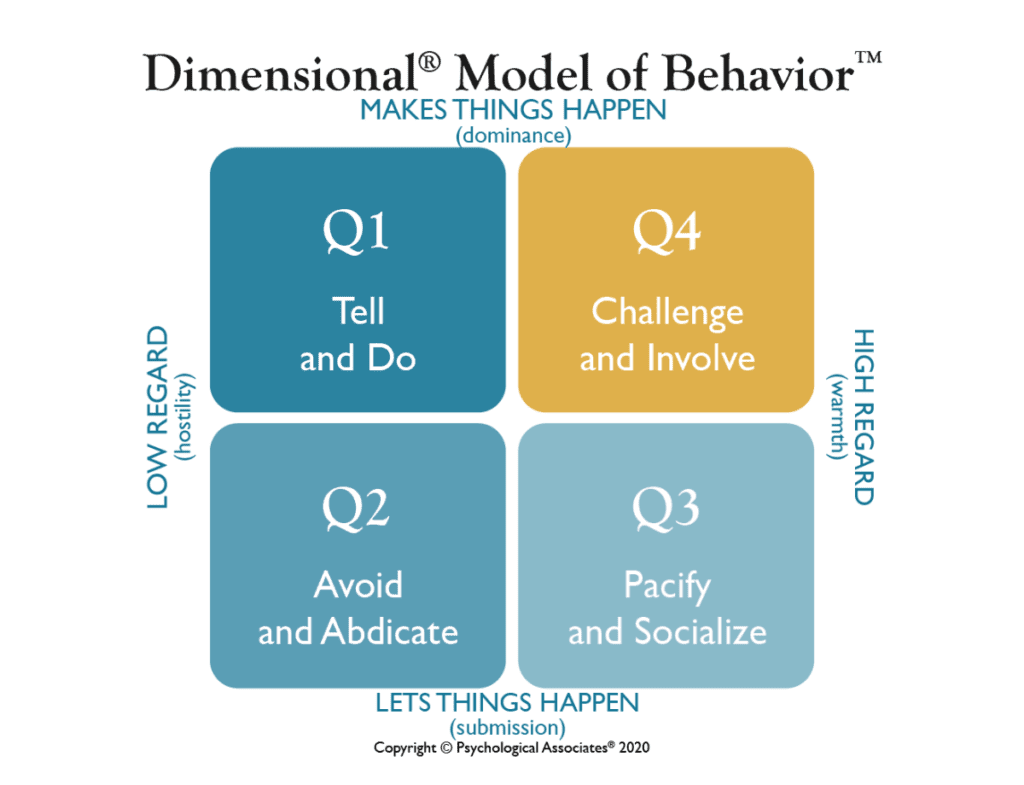Everyone has a horror story of a bad boss from their past. Some of them are legendarily bad, like the guy who asked his employees to help him hide his affairs from his spouse. Or you might have heard of bosses who make weird requests like coming up with science fair project ideas for the boss’ kid, or even ask their employees to clip their dog’s nails. Ugh!
But sometimes a boss’ bad behavior can be trickier to identify. You know something is … off … but it’s harder to articulate what’s going wrong. We’re here to help you identify three kinds of bad bosses you might meet at work — and give you some Q4 strategies to improve your working relationship.
The Dimensional® Model of Behavior™
Our Dimensional Model of Behavior organizes aspects of objective, observable behavior into four quadrants. The better you understand behavior, the more effectively you can respond to it.
When it comes to the model, the gold standard is Q4 behavior – demonstrating a high regard for others without sacrificing results. Our goal is to exhibit this behavior ourselves, and to draw it out of others. We’ll use this framework when responding to our legendarily bad bosses below, so keep it in mind!

Bad Boss #1: The Egomaniac
This boss gets things done, that’s for sure. There’s a lot of yelling and a lot of drama, though, and not much collaboration. Employees feel pressured, and don’t hear about their value to the team or the organization.
Working With a Q1 Boss
We call this type of behavior Q1. It’s categorized by a Tell & Do approach to work. Rather than collaborating with others, Q1 believes that people have to be pushed. Q1’s tendency is to intimidate through power, and uses threats to drive direct reports toward a suitable level of performance.
Q1 does get things done — but compliance usually doesn’t result in commitment. People who work with a Q1 boss often aren’t good at problem-solving or decision-making. That’s because they’re so afraid of the boss’ scorn and derision that they’d rather not speak up at all. They behave defensively, and as a result, the organization loses out on their insights and potential innovations.
So how can you be Q4 with a Q1 boss? Use benefit statements around independence, ego, and power to get their buy-in. Be responsive and direct — and show your confidence. You’re more likely to gain Q1’s respect by matching their above-the-line dominance with your own assertive behavior.
Bad Boss #2: The Naysayer
Quite simply, The Naysayer is afraid of risk and change. This boss will postpone decision-making for as long as possible — maybe forever if that’s a viable option. Providing little feedback and holding onto the status quo, a boss like this is seldom seen or heard from.
Working With a Q2 Boss
On our Dimensional Model, this is known as Q2 behavior. Q2 bosses are recognized by their Avoid & Abdicate style of management. Like Q1, Q2 isn’t interested in collaboration. But where a Q1 boss is overly dominant, the Q2 boss practically disappears. Q2 rarely lets direct reports know where they stand — good or bad. There are no consequences for undesirable direct report behavior, but no rewards for positive behavior, either.
As a result, team members stick to the routine, rarely displaying initiative or innovation. After all, if the boss doesn’t care, why should they? The Q2 manager and the team end up procrastinating on a lot of important decisions and projects. Everyone ends up putting off ideas that might feel uncomfortable or disruptive. Decision-making gets postponed, and problems aren’t addressed.
It can feel challenging to try to be Q4 with a Q2 boss. Appealing to their need for stability and predictability with a strong benefit statement can help. You’ll need to slow down your pace to give them time to consider your ideas. Be patient and reassuring throughout the conversation. And use lots of open-end probes and pauses — providing the space for Q2 to articulate their concerns increases the likelihood of their buy-in.
Bad Boss #3: The Best Buddy
What’s so bad about the boss who wants to be your friend? They’re focused on others, which is more than you can say for Q1 and Q2. However, the Best Buddy Boss focuses so much on wanting everyone to feel relaxed and happy that problems are downplayed — or entirely ignored.
Working With a Q3 Boss
A boss who’s Q3 finds meaning in a Pacify & Socialize set of behaviors. They’re agreeable and eager to please. However, that overarching need for everyone to get along means that Q3 bosses tend to vacillate over decisions, gloss over problems, and compromise too quickly. They ignore troublesome issues in a way that leaves their team unprepared to deal with the consequences that inevitably arise.
In trying so hard to set an overly positive tone, Q3 often finds that their team doesn’t perform at optimal productivity. Team members are often confused about the real situation at hand, and unclear about their performance. Most employees crave a clarity and openness that are unlikely with a Q3 boss. Because they rarely know where the Q3 boss stands, they rarely know where they stand, too.
When working with a Q3 boss, a few Q4 strategies stand out. You want to set a friendly tone that keeps them engaged — but guide the discussion with a steady focus. Where Q1 may be quick to argue, and Q2 might hesitate to commit to any kind of binding decision, Q3 could actually agree too quickly. Q3 might concur merely in the interest of getting along; probe that easy agreement with closed-end questions and summary statements.
Q4 Behavior Rises Above
No matter if your boss is Q1, Q2, or Q3, they’ll still have more power than you. You can’t order or demand anything of them; instead, you’ll have to use your Q4 powers of persuasion. Employing Q4 behavioral strategies might not turn any of these bosses from nightmares into your dream working relationship. Q4 behavior can be challenging, and it takes effort. But it’ll help you bring out the best in others — and in you as well.




